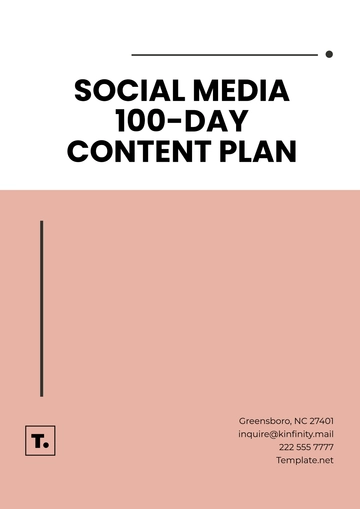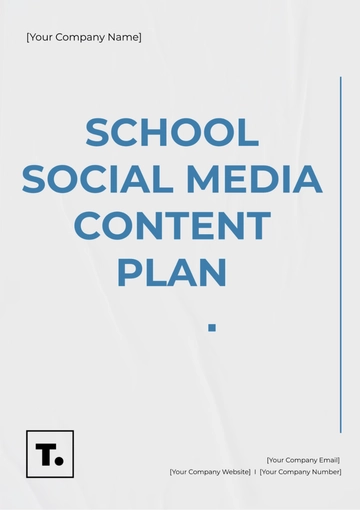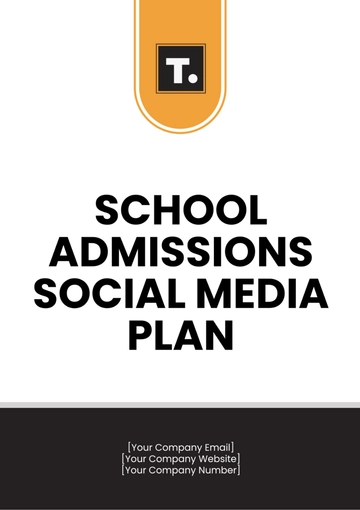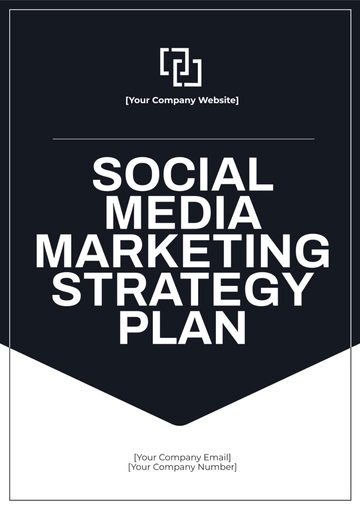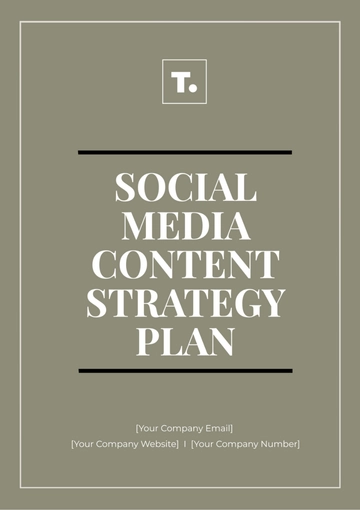Free Spa Social Media Plan

I. Introduction
A. Purpose of the Plan
The purpose of this social media plan is to establish a structured approach to enhance the online presence of [Your Company Name], a premier spa offering a wide range of wellness services. This plan aims to increase brand awareness, engage with our audience, attract new clients, and retain existing ones through strategic use of various social media platforms. By leveraging the power of social media, we can reach a larger audience, create meaningful connections, and position [Your Company Name] as a leader in the wellness industry. The plan will also guide our efforts in creating and distributing high-quality content that resonates with our target audience, ensuring that our brand remains top-of-mind for potential and existing clients.
B. Objectives
The primary objectives of this social media plan are:
Increase Brand Awareness: To increase brand awareness by 50% over the next 12 months through consistent and strategic posting across all platforms, thereby reaching a wider audience and establishing a strong online presence.
Grow Followers: To grow our social media followers by 30% within six months by engaging with our audience through interactive content, contests, and collaborations with influencers.
Boost Engagement Rates: To achieve a 20% increase in engagement rates across all social media platforms by creating compelling content that encourages likes, comments, and shares.
Drive Website Traffic: To drive a 25% increase in website traffic from social media channels by including clear calls-to-action and direct links to our website in our posts.
Generate More Bookings: To generate 10% more bookings through social media promotions and campaigns by offering exclusive deals and showcasing our services in a way that appeals to potential clients.
C. Target Audience
Our target audience includes:
Primary Audience: Women aged 25-45 who are health-conscious, value self-care, and have disposable income for spa services. These women are likely to be professionals or stay-at-home moms who prioritize their well-being and are looking for ways to relax and rejuvenate.
Secondary Audience: Men aged 30-50 who seek relaxation and wellness services. This group includes professionals who are often stressed and in need of relaxation, as well as men who are becoming increasingly aware of the importance of self-care.
Tertiary Audience: Young professionals and millennials interested in modern wellness trends and luxury experiences. This group is tech-savvy, active on social media, and influenced by trends and recommendations from peers and influencers.
D. Social Media Platforms
The social media platforms we will utilize are:
Facebook: To reach a broad audience and share detailed posts, events, and promotions. Facebook allows us to create a community through our page where we can interact with clients, share updates, and promote our services.
Instagram: To showcase visually appealing content, including spa treatments, client testimonials, and wellness tips. Instagram’s visual nature is perfect for highlighting the aesthetic aspects of our spa and engaging with a younger audience.
Twitter: For quick updates, customer service, and engaging with trending topics. Twitter is ideal for sharing real-time information and engaging with clients in a more casual and immediate manner.
Pinterest: To share inspirational wellness content, DIY spa treatments, and lifestyle tips. Pinterest allows us to reach users who are looking for ideas and inspiration related to wellness and self-care.
YouTube: To provide video content such as tutorials, behind-the-scenes looks at our spa, and client testimonials. YouTube is a powerful platform for sharing in-depth content that can educate and engage our audience.
II. Social Media Strategy
A. Content Creation
Types of Content
Educational Posts: Articles and infographics about the benefits of various spa treatments. These posts will position [Your Company Name] as an authority in the wellness industry and provide valuable information to our audience.
Promotional Posts: Announcements of special offers, discounts, and events. These posts will create a sense of urgency and encourage followers to take advantage of limited-time offers.
Visual Content: High-quality images and videos showcasing spa services and ambiance. Visual content is highly engaging and will help us capture the attention of potential clients.
User-Generated Content: Encouraging clients to share their experiences and tag [Your Company Name]. User-generated content builds trust and authenticity, as potential clients are more likely to trust the experiences of other customers.
Content Calendar
Week | YouTube | ||||
|---|---|---|---|---|---|
1 | Blog Post about Benefits of Massage | Client Testimonial Video | Daily Wellness Tips | DIY Facial Mask Pin | Behind-the-Scenes Video |
2 | Promotion Announcement | Before and After Images | Live Q&A Session | Healthy Recipes Pin | Tutorial: At-Home Spa Day |
3 | Event Invitation | Client Stories Highlight | Fun Fact About Spa | Meditation Tips Pin | Interview with a Wellness Expert |
4 | Monthly Newsletter | Wellness Quotes | Poll: Favorite Treatment | Spa Decor Ideas Pin | Guided Meditation Video |
The content calendar will be reviewed and updated monthly to ensure it remains relevant and aligned with our goals. This calendar will guide our posting schedule, ensuring consistency and helping us stay organized.
B. Posting Frequency
Facebook: 3-5 times per week. This frequency will allow us to stay top-of-mind for our followers without overwhelming them with too many posts.
Instagram: Daily posts and stories. Instagram’s algorithm favors regular posting, and daily content will help us maintain high visibility and engagement.
Twitter: 3-4 times daily. Twitter’s fast-paced nature requires frequent posting to remain relevant and engage with trending topics.
Pinterest: 5-7 pins per week. Consistent pinning will help us build a presence on Pinterest and reach users searching for wellness and self-care inspiration.
YouTube: 1-2 videos per month. Creating high-quality video content takes time, and this frequency will ensure we can produce engaging and informative videos without compromising quality.
C. Engagement Strategy
Responding to Comments and Messages
Ensure all comments and messages are responded to within 24 hours. Timely responses show that we value our clients and are attentive to their needs.
Use a friendly and professional tone in all interactions. Maintaining a consistent and positive brand voice is crucial for building a strong relationship with our audience.
User Interaction
Host monthly live Q&A sessions on Facebook and Instagram. These sessions will provide an opportunity for followers to interact directly with our team, ask questions, and learn more about our services.
Create polls and questions to encourage audience interaction. Interactive content is highly engaging and helps us gather valuable feedback from our audience.
Acknowledge and share user-generated content. Sharing content from our clients shows that we appreciate their support and encourages others to share their experiences as well.
Hashtags and Keywords
Use relevant hashtags like #WellnessWednesday, #SelfCareSunday, and #SpaDay. Hashtags increase the discoverability of our posts and help us reach a broader audience.
Incorporate keywords such as "relaxation," "wellness," and "luxury spa" in posts to improve searchability. Keywords will enhance our content’s SEO, making it easier for potential clients to find us.
D. Influencer Collaborations
Identifying Influencers
Look for local influencers with 10,000-50,000 followers who align with our brand values. These influencers have a dedicated following that trusts their recommendations, making them ideal partners for promoting our spa.
Evaluate potential influencers based on their engagement rates and the quality of their content. High engagement rates indicate that the influencer’s followers are genuinely interested in their content.
Collaboration Types
Sponsored posts showcasing their experience at [Your Company Name]. These posts will reach the influencer’s followers and provide authentic endorsements of our services.
Hosting giveaways or contests in partnership with influencers. Giveaways can generate excitement and increase our reach as followers share the contest with their networks.
Inviting influencers to exclusive events or treatments and sharing their experiences on social media. This type of collaboration provides behind-the-scenes content that is engaging and exclusive.
E. Advertising Strategy
Facebook Ads
Create targeted ads to reach specific demographics, interests, and behaviors. Facebook’s advanced targeting options allow us to reach the exact audience we want to attract to our spa.
Allocate a monthly budget of $1,000 for Facebook ads, aiming to achieve a CPC (Cost Per Click) of $0.50. Regularly monitor ad performance and adjust targeting and budget as needed to optimize results.
Instagram Ads
Use visually engaging ads in Stories and Feed to attract new clients. Instagram’s ad formats are highly effective for showcasing the visual appeal of our spa services.
Allocate a monthly budget of $500 for Instagram ads with a goal to achieve a CTR (Click-Through Rate) of 1.5%. Monitor ad performance to ensure we are meeting our goals and adjust as needed.
Pinterest Ads
Promote pins that link to our blog or booking page. Pinterest users are often in discovery mode, looking for ideas and inspiration, making it a great platform for driving traffic to our website.
Allocate a monthly budget of $300 for Pinterest ads, aiming for a CPA (Cost Per Acquisition) of $5. Track the performance of promoted pins and optimize for better results.
III. Measurement and Analytics
A. Key Performance Indicators (KPIs)
Brand Awareness
Follower Growth: Track the number of new followers gained on each social media platform. This metric will help us understand how well our brand is attracting new audience members.
Mentions and Shares: Monitor the number of times our brand is mentioned and shared by users. This indicates how frequently our audience is talking about and recommending our spa to others.
Engagement Rates
Post Engagement: Measure the total number of likes, comments, and shares our posts receive. High engagement rates suggest that our content resonates with our audience.
Engagement Rate Percentage: Calculate this by dividing the total engagements by the total number of followers and multiplying by 100. This percentage gives a clear picture of how engaged our audience is relative to our follower count.
Website Traffic
Social Media Referrals: Use Google Analytics to track how much of our website traffic comes from social media channels. This will help us understand the effectiveness of our social media efforts in driving visitors to our site.
Bounce Rate: Monitor the percentage of visitors who leave our site after viewing only one page. A lower bounce rate from social media referrals indicates that our content is relevant and engaging.
Average Session Duration: Track how long visitors from social media stay on our website. Longer sessions suggest that users find our content valuable and are exploring more pages.
Conversion Rates
Bookings from Social Media: Track the number of bookings made through social media promotions. This metric directly measures the impact of our social media efforts on our bottom line.
Conversion Rate: Calculate this by dividing the total number of conversions by the total number of clicks and multiplying by 100. This percentage indicates the effectiveness of our social media campaigns in converting followers into clients.
B. Tools for Analytics
Facebook Insights
Provides detailed analytics on page performance, audience demographics, and engagement. This tool helps us understand which types of content perform best and how our audience interacts with our posts.
Instagram Insights
Offers data on post performance, follower activity, and engagement metrics. Instagram Insights will help us tailor our content to what our audience enjoys most and identify peak times for posting.
Google Analytics
Tracks website traffic, user behavior, and conversion data from social media. Google Analytics is essential for understanding the overall effectiveness of our social media efforts in driving business results.
Hootsuite Analytics
Aggregates data from multiple social media platforms for comprehensive reporting. Hootsuite’s analytics feature allows us to monitor performance across all our social media channels in one place.
Sprout Social
Offers advanced analytics and reporting features to measure social media performance. Sprout Social provides in-depth insights and helps us create detailed reports to share with stakeholders.
C. Reporting Schedule
Weekly Reports
Summarize key metrics such as follower growth, engagement rates, and top-performing posts. Weekly reports allow us to quickly identify trends and make necessary adjustments to our strategy.
Monthly Reports
Provide a detailed analysis of social media performance, including traffic and conversion rates. Monthly reports give a broader view of our progress and help us plan for the upcoming month.
Quarterly Reviews
Assess the overall effectiveness of the social media strategy and make necessary adjustments. Quarterly reviews provide an opportunity to evaluate long-term trends and measure progress towards our objectives.
Annual Reports
Evaluate the success of long-term objectives and set new goals for the upcoming year. Annual reports are essential for strategic planning and ensuring that our social media efforts align with our business goals.
IV. Budget and Resources
A. Budget Allocation
Category | Monthly Budget | Annual Budget |
|---|---|---|
Content Creation | $2,000 | $24,000 |
Advertising | $1,800 | $21,600 |
Influencer Collaborations | $1,000 | $12,000 |
Tools and Analytics | $500 | $6,000 |
Miscellaneous | $200 | $2,400 |
Total | $5,500 | $66,000 |
The budget allocation ensures that we have the necessary resources to create high-quality content, run effective advertising campaigns, and collaborate with influencers. By investing in these areas, we can maximize the impact of our social media efforts and achieve our business objectives.
B. Resource Allocation
Content Creation Team
Hire a social media manager to oversee the strategy and execution. The social media manager will be responsible for planning, creating, and scheduling content, as well as analyzing performance metrics.
Employ a graphic designer for visual content. High-quality visuals are crucial for capturing the attention of our audience and maintaining a professional brand image.
Utilize freelance writers for blog posts and articles. Experienced writers can produce informative and engaging content that educates our audience and positions [Your Company Name] as an industry expert.
Community Management
Assign a dedicated team member to handle comments, messages, and customer service inquiries. Prompt and professional responses are essential for building and maintaining a positive relationship with our audience.
Advertising Management
Work with a digital marketing agency to manage and optimize ad campaigns. An experienced agency can help us achieve the best possible return on investment for our advertising budget.
Analytics and Reporting
Use tools like Hootsuite and Google Analytics for tracking and reporting. These tools provide detailed insights into our social media performance and help us make data-driven decisions.
Allocate a team member to compile and analyze data. Regular analysis and reporting ensure that we stay on track to meet our goals and can quickly identify and address any issues.
V. Conclusion
A. Summary
The social media plan for [Your Company Name] is designed to build a strong online presence, engage with our target audience, and drive business growth through strategic content creation, advertising, and engagement tactics. By consistently monitoring performance and adjusting our strategy, we aim to achieve our objectives and establish [Your Company Name] as a leading spa in the wellness industry. This comprehensive approach will help us reach a wider audience, foster meaningful connections, and convert followers into loyal clients.
B. Next Steps
Implement the Social Media Plan
Begin by setting up a content calendar and scheduling posts. This ensures that we have a steady stream of content ready to go and can maintain a consistent posting schedule.
Launch initial advertising campaigns and influencer collaborations. These efforts will help us quickly gain visibility and attract new followers.
Monitor and Adjust
Regularly review analytics and adjust the strategy as needed to ensure goals are being met. By staying flexible and responsive, we can continually improve our social media performance.
Evaluate and Report
Conduct quarterly reviews and annual evaluations to measure success and plan for future improvements. Regular evaluation helps us stay on track and ensures that our social media efforts continue to support our business objectives.
- 100% Customizable, free editor
- Access 1 Million+ Templates, photo’s & graphics
- Download or share as a template
- Click and replace photos, graphics, text, backgrounds
- Resize, crop, AI write & more
- Access advanced editor
Maximize your spa's online presence with the Spa Social Media Plan Template from Template.net. This editable and customizable document provides a structured framework for planning and executing social media strategies tailored to your spa. Crafted for effectiveness, it's editable in our AI Editor Tool, ensuring your spa stands out on social platforms.
You may also like
- Finance Plan
- Construction Plan
- Sales Plan
- Development Plan
- Career Plan
- Budget Plan
- HR Plan
- Education Plan
- Transition Plan
- Work Plan
- Training Plan
- Communication Plan
- Operation Plan
- Health And Safety Plan
- Strategy Plan
- Professional Development Plan
- Advertising Plan
- Risk Management Plan
- Restaurant Plan
- School Plan
- Nursing Home Patient Care Plan
- Nursing Care Plan
- Plan Event
- Startup Plan
- Social Media Plan
- Staffing Plan
- Annual Plan
- Content Plan
- Payment Plan
- Implementation Plan
- Hotel Plan
- Workout Plan
- Accounting Plan
- Campaign Plan
- Essay Plan
- 30 60 90 Day Plan
- Research Plan
- Recruitment Plan
- 90 Day Plan
- Quarterly Plan
- Emergency Plan
- 5 Year Plan
- Gym Plan
- Personal Plan
- IT and Software Plan
- Treatment Plan
- Real Estate Plan
- Law Firm Plan
- Healthcare Plan
- Improvement Plan
- Media Plan
- 5 Year Business Plan
- Learning Plan
- Marketing Campaign Plan
- Travel Agency Plan
- Cleaning Services Plan
- Interior Design Plan
- Performance Plan
- PR Plan
- Birth Plan
- Life Plan
- SEO Plan
- Disaster Recovery Plan
- Continuity Plan
- Launch Plan
- Legal Plan
- Behavior Plan
- Performance Improvement Plan
- Salon Plan
- Security Plan
- Security Management Plan
- Employee Development Plan
- Quality Plan
- Service Improvement Plan
- Growth Plan
- Incident Response Plan
- Basketball Plan
- Emergency Action Plan
- Product Launch Plan
- Spa Plan
- Employee Training Plan
- Data Analysis Plan
- Employee Action Plan
- Territory Plan
- Audit Plan
- Classroom Plan
- Activity Plan
- Parenting Plan
- Care Plan
- Project Execution Plan
- Exercise Plan
- Internship Plan
- Software Development Plan
- Continuous Improvement Plan
- Leave Plan
- 90 Day Sales Plan
- Advertising Agency Plan
- Employee Transition Plan
- Smart Action Plan
- Workplace Safety Plan
- Behavior Change Plan
- Contingency Plan
- Continuity of Operations Plan
- Health Plan
- Quality Control Plan
- Self Plan
- Sports Development Plan
- Change Management Plan
- Ecommerce Plan
- Personal Financial Plan
- Process Improvement Plan
- 30-60-90 Day Sales Plan
- Crisis Management Plan
- Engagement Plan
- Execution Plan
- Pandemic Plan
- Quality Assurance Plan
- Service Continuity Plan
- Agile Project Plan
- Fundraising Plan
- Job Transition Plan
- Asset Maintenance Plan
- Maintenance Plan
- Software Test Plan
- Staff Training and Development Plan
- 3 Year Plan
- Brand Activation Plan
- Release Plan
- Resource Plan
- Risk Mitigation Plan
- Teacher Plan
- 30 60 90 Day Plan for New Manager
- Food Safety Plan
- Food Truck Plan
- Hiring Plan
- Quality Management Plan
- Wellness Plan
- Behavior Intervention Plan
- Bonus Plan
- Investment Plan
- Maternity Leave Plan
- Pandemic Response Plan
- Succession Planning
- Coaching Plan
- Configuration Management Plan
- Remote Work Plan
- Self Care Plan
- Teaching Plan
- 100-Day Plan
- HACCP Plan
- Student Plan
- Sustainability Plan
- 30 60 90 Day Plan for Interview
- Access Plan
- Site Specific Safety Plan
